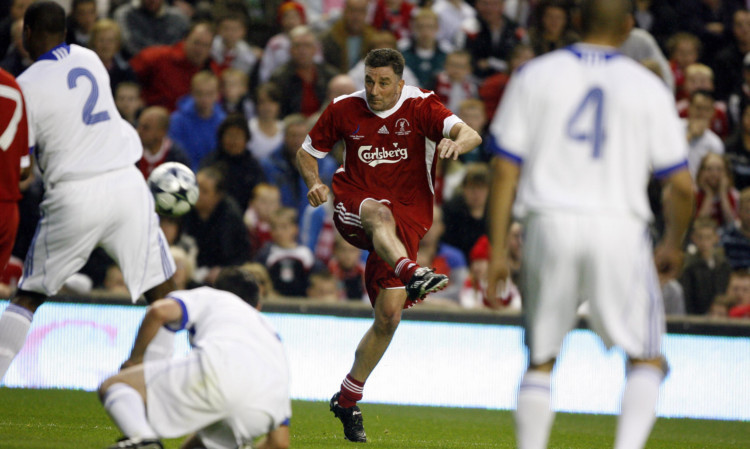
“Liverpool wouldn’t be the club it is today without the influence of the Scots.”
Liverpool are heading towards securing the English title without a Scot for the first time since the Second World War.
The Tartan influence at Anfield has loomed large over the years, with a number of legendary figures at the club all coming from north of the border.
But as Brendan Rodgers edges his team ever closer to ending a 24-year drought as the top dogs south of Hadrian’s Wall, it is Uruguayan Luis Suarez, Brazilian Philippe Coutinho, Steven Gerrard and an assortment of his fellow Englishmen who are leading the way.
Reds legend John Aldridge grew up standing on The Kop watching Scotsmen playing for his boyhood heroes, and shared a dressing-room with many when Kenny Dalglish signed him for the club.
“Liverpool Football Club is synonymous with Scotsmen,” says Aldridge. “Quite simply, Liverpool wouldn’t be the club it is without the influence of those people.
“You’ll hear supporters refer to them as Bravehearts of The Kop, and they all hold a very special place in the club’s history.
“Bill Shankly, of course, is a legendary figure. There are still massive banners displayed by fans at Anfield during every matchday, paying tribute to him and his achievements as manager.
“And if you were to compile a list of the most popular players ever to have played for the club, then there would be no shortage of Scotsmen in it. That’s how big a part they’ve played in the club’s history.”
Aldridge admits the Scottish players playing for Liverpool during his childhood had a massive influence on encouraging him to follow in their footsteps.
“I grew up watching the likes of Tommy Lawrence, Willie Stevenson, Ron Yeats and Ian St John,” Aldridge continues. “They were all tremendous footballers and are quite rightly regarded at Liverpool legends.
“And, of course, there was Bill Shankly as manager.
“Then the likes of Graeme Souness and Kenny Dalglish came along, and I wanted to follow in their footsteps.”
Aldridge, of course, was fortunate enough to do just that when Dalglish signed him to replace Ian Rush in the Liverpool attack in 1987. He found himself sharing a dressing-room with yet another Scottish contingent, not unlike the one he had grown up watching.
“I played in the same team as Gary Gillespie, Stevie Nicol and Alan Hansen,” says Aldridge. “The three of them were incredible players.
“Big Alan has gone on to make a second career for himself on Match of the Day, and he may seem as laid-back there as he sometimes did on the pitch. But, believe me, the big man could give you a right good rollicking when required!
“And, of course, Kenny Dalglish was the manager and we enjoyed a lot of success in what was a great period for the club.
“We won the League in season 1987-88. I managed to score 26 goals during that campaign and it was a wonderful side we had at that time.
“The three team-mates I mentioned were all terrific defenders and, as someone who played at the opposite end of the pitch, I always appreciated the jobs they performed.
“They were all great competitors, fantastic defenders and very gifted footballers.”
The fact there is no longer any Scottish influence whatsoever at Liverpool is as clear an indication as you’ll get that the country no longer produces the players it once did.
Charlie Adam is the most recent to have occupied a spot in the Reds’ first-team, but he was shipped out when Brendan Rodgers took over the club.
Aldridge says: “I don’t want to appear disrespectful towards the current crop of Scottish players by saying none of them are good enough to play for Liverpool.
“What I would say, like the Republic of Ireland, Scotland are going through a period of transition, and they’ve not managed to produce the same quality of players as years gone by.
“The reason for that, in my opinion, was that too many foreign players were brought in at the expense of home-grown youngsters.
“It was much more difficult for them to break into the first-team and therefore it impacted on the amount of Scottish players coming through the ranks.
“But I keep an eye on Scottish football, and I know things have now changed and young players are coming through at a number of clubs.
“Gordon Strachan has made a big difference to the national team since he took over, and Scottish football is definitely on the up.
“So I’d love to see a return of the Scottish influence at Anfield in the future and I’m sure that will happen.
“I’m not going to tempt fate by saying this is the year Liverpool will win the League, but the team are in a good position.
“And because of the club’s close connections, I’m sure there are a lot of Scottish people rooting for Liverpool to do it.”

Enjoy the convenience of having The Sunday Post delivered as a digital ePaper straight to your smartphone, tablet or computer.
Subscribe for only £5.49 a month and enjoy all the benefits of the printed paper as a digital replica.
Subscribe